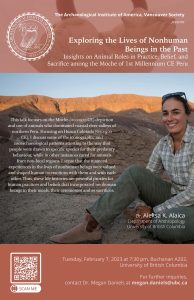Dr. Aleksa Alaica Department of Anthropology, UBC
Location: UBC-Vancouver Buchanan A 202
Please join the Archaeological Institute of America’s Vancouver Society and the AMNE department in welcoming Dr. Aleksa Alaica for a lecture that takes us beyond the AIA’s traditional focus on the Mediterranean and Near East. We will learn about the fascinating intertwinements of humans and animals in first-millennium South America!


Archaeology is focused on cultural practices of past groups, with the central focus being on humans. We often forget though that animals are essential agents in our everyday lives, whether they be for food, labour, or companionship. This talk focuses on the Moche (200-900 CE) depiction and use of animals who dominated coastal river valleys of northern Peru. Their vivid and extensive iconographic record often represents animals in their own natural events, as food offerings, sacrifices and even anthropomorphized figures involved in elite activities. In tandem with this visual record, Moche archaeological contexts yield abundant animal bone remains that provides us with insights on their lived experiences and depositional histories. Focusing on the site of Huaca Colorada (600-900 CE), I discuss some of the iconographic and zooarchaeological patterns attesting to the way that people were drawn to specific species for their predatory behaviour, while in other instances cared for animals known to original from non-local regions. I argue that the nuanced experiences in the lives of nonhuman beings were valued and shaped human interactions with them and with each other. Thus, these life histories are powerful proxies for human practices and beliefs that incorporated nonhuman beings in their meals, their ceremonies and as sacrifices.